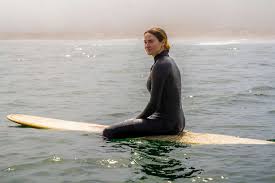In Shailene Woodley’s sunny childhood, water was a pleasant distraction.
She grew up in upscale Simi Valley, taking family trips to nearby Malibu. “We would often camp near the ocean,” she told the Television Critics Association. “And because my parents weren’t afraid of water, they taught my brother and I to be very brave and respectful of the ocean.”
At 32, she’s a movie star (“Divergent,” “The Fault in Our Stars”), a TV star (“Big Little Lies”), a surfer and an ocean advocate. That’s what brings her back to TV, for “Hope in the Water” (shown here) at 9 p.m. Wednesdays on PBS.
The three-week documentary says Americans focus on a few choices – tuna, salmon and shrimp – that get overfished, while others are ignored. “There are literally other fish in the sea,” Baratunde Thurston said.
In the June 19 opener, he watches Puerto Rican fishermen catch squid and popularize it in restaurants. That hour also has two examples of areas – off Hawaii and a small Scottish island – where most fishing is banned.
“In terms of cordoning off certain areas, we need to give nature a chance to heal itself,” Thurston said. “And if we get out of the way, in part, it will.”
A week later (June 26), Martha Stewart visits “aquaculture” fish farms. The final hour (July 3) returns to that try-other-fish idea.
In a typical Asian market, Talia Young says, there are about 35 kinds of fish. She links Philadelphia families with ones that are abundant, but overlooked.
There are plenty, producer Andrew Zimmern said. “The majority of fish caught by the U.S. fleets are sold overseas. (Americans’ focus on) just a few species of fish has driven the price up.”
That third hour also has Woodley’s personal touch..
“I surf a lot in Malibu,” she said. If the waves were dull, “we’d bring oute masks out and … try to find sand dollars on the bottom.”
But after being away, filming overseas, she found “the entire ocean floor was littered with urchins. I remember my jaw dropping.”
The spiked, purple urchins are pretty to look at, horrendous to step on and suddenly overtaking Southern California for assorted reasons. “I didn’t know anything about urchins before doing this show,” Woodley said.
Now she knows plenty. She watched people grab them from the ocean floor, take them to an abalone farmer who feeds them seaweed, then harvests their innards. The result is a delicacy she calls “Disneyland in one bite.”
She’s not the only Hollywood link to the “Hope in the Wate.r” David E. Kelley – who has written and produced top shows (including “Big Little Lies,” starring Woodley) co-produced the series, his first non-fiction piece.
“Everybody knows him for his 500 Emmys,” Zimmern said, exaggerating a tad. (Kelley has 11, plus 15 more nominations). “He is also one of the most committed proponents of aquaculture that I’ve ever seen,”
Kelley even has a large trout farm in Idaho. Now his series views people who have taken similar steps.

A longtime love for (and worry about) oceans
In Shailene Woodley’s sunny childhood, water was a pleasant distraction.
She grew up in upscale Simi Valley, taking family trips to nearby Malibu. “We would often camp near the ocean,” she told the Television Critics Association. “And because my parents weren’t afraid of water, they taught my brother and I to be very brave and respectful of the ocean.”
At 32, she’s a movie star (“Divergent,” “The Fault in Our Stars”), a TV star (“Big Little Lies”), a surfer and an ocean advocate. That’s what brings her back to TV, for “Hope in the Water” (shown here) at 9 p.m. Wednesdays on PBS. Read more…